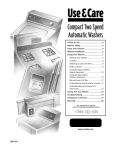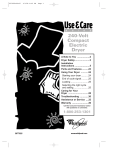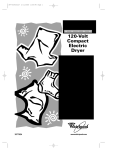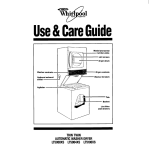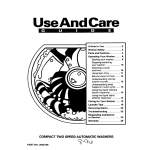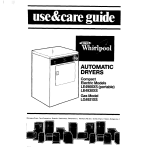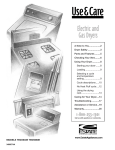Download Whirlpool 3977631 Owner`s manual
Transcript
3977631 v12 c51 3/22/99 5:11 PM Page 1 120-Volt Compact Electric Dryer A Note to You....................2 Dryer Safety ......................3 Installation Instructions.......................5 Parts and Features.........13 Using Your Dryer ............14 Starting your dryer ......…14 End of cycle signal..........15 Loading ...........................15 Selecting the right cycle and setting ......................15 Caring for Your Dryer ...............................18 Troubleshooting .............20 Assistance or Service....22 Warranty ..........................24 1-800-253-1301 Call the Consumer Assistance Center with questions or comments. ® 3977631 www.crosley.com 3977631 v12 c51 3/22/99 5:11 PM Page 2 A Note to You Thank you for buying a CROSLEY® appliance. To ensure that you enjoy years of trouble-free operation, we developed this Use and Care Guide. It is full of valuable information about how to operate and maintain your appliance properly and safely. Please read it carefully. Also, please complete and mail the Product Registration Card provided with your appliance. The card helps us notify you about any new information on your appliance. Please record your model’s information. Whenever you call to request service for your appliance, you need to know your complete model number and serial number. You can find this information on the model and serial number label/plate (see the diagram in the “Parts and Features” section). Please also record the purchase date of your appliance and your dealer’s name, address, and telephone number. Model Number ______________________ Serial Number ______________________ Purchase Date ______________________ Dealer Name ________________________ Dealer Address ______________________ Dealer Phone ________________________ Keep this book and the sales slip together in a safe place for future reference. It is important for you to save your sales receipt showing the date of purchase. Proof of purchase will assure you of in-warranty service. The Consumer Assistance Center number is toll free. 2 1-800-253-1301 3977631 v12 c51 3/22/99 5:11 PM Page 3 Dryer Safety Your safety and the safety of others is very important. We have provided many important safety messages in this manual and on your appliance. Always read and obey all safety messages. This is the safety alert symbol. This symbol alerts you to hazards that can kill or hurt you and others. All safety messages will be preceded by the safety alert symbol and the word “DANGER” or “WARNING.” These words mean: wDANGER You will be killed or seriously injured if you don’t follow instructions. wWARNING You can be killed or seriously injured if you don’t follow instructions. All safety messages will identify the hazard, tell you how to reduce the chance of injury, and tell you what can happen if the instructions are not followed. 3 3977631 v12 c51 3/22/99 5:11 PM Page 4 DRYER SAFETY IMPORTANT SAFETY INSTRUCTIONS WARNING: To reduce the risk of fire, electric shock, or injury to persons when using the dryer, follow basic precautions, including the following: • Read all instructions before using the dryer. • Do not place items exposed to cooking oils in your dryer. Items contaminated with cooking oils may contribute to a chemical reaction that could cause a load to catch fire. • Do not dry articles that have been previously cleaned in, washed in, soaked in, or spotted with gasoline, dry-cleaning solvents, other flammable, or explosive substances as they give off vapors that could ignite or explode. • Do not allow children to play on or in the dryer. Close supervision of children is necessary when the dryer is used near children. • Before the dryer is removed from service or discarded, remove the door to the drying compartment. • Do not reach into the dryer if the drum is moving. • Do not install or store the dryer where it will be exposed to the weather. • Do not tamper with controls. • Do not repair or replace any part of the dryer or attempt any servicing unless specifically recommended in this Owner’s Manual or in published user-repair instructions that you understand and have the skills to carry out. • Do not use fabric softeners or products to eliminate static unless recommended by the manufacturer of the fabric softener or product. • Do not use heat to dry articles containing foam rubber or similarly textured rubber-like materials. • Clean lint screen before or after each load. • Keep area around the exhaust opening and adjacent surrounding areas free from the accumulation of lint, dust, and dirt. • The interior of the dryer and exhaust vent should be cleaned periodically by qualified service personnel. • See Installation Instructions for grounding requirements. SAVE THESE INSTRUCTIONS IMPORTANT: Observe all governing codes and ordinances. 4 3977631 v12 c51 3/22/99 5:11 PM Page 5 Installation Instructions Read the “Dryer Safety” section of your dryer’s Use and Care guide, and completely read these installation instructions before beginning installation. Before starting installation 203⁄4" ➤ ➤ ➤ wWARNING *31" ➤ 237⁄8" ➤ • Check location where dryer will be installed. Proper installation is your responsibility. The dryer must not be installed or stored in an area where it will be exposed to water and/or weather. Make sure you have everything necessary for correct installation. • Grounded electrical supply is required. See “Electrical requirements.” • Four-inch metal exhaust vent is required. See “Exhaust requirements.” • Check code requirements: Some codes do not permit or limit installation of clothes dryers in garages, closets, mobile homes, or sleeping quarters. Contact your local building inspector. • Protection from the weather: Proper operation of dryer cycles requires temperatures above 45°F, or the dryer may not shut off when automatic cycles are used. ➤ Explosion Hazard Keep flammable materials and vapors, such as gasoline, away from dryer. Place dryer at least 18 inches (46 cm) above the floor for a garage installation. Failure to do so can result in death, explosion, or fire. *Height with casters is 321⁄2" • Support: Floor must be sturdy enough to support dryer weight and load of 110 lb. • Location: Must be large enough to fully open dryer door. See “Recessed area and closet installation.” • Level floor: 1 in maximum slope under entire dryer. NOTE: Observe all governing codes and ordinances. 5 3977631 v12 c51 3/22/99 5:11 PM Page 6 INSTALLATION INSTRUCTIONS Electrical Requirements WARNING Electrical Shock Hazard Plug into a grounded 3 prong outlet. Do not remove ground prong. Do not use an adapter. Do not use an extension cord. Failure to follow these instructions can result in death, fire, or electrical shock. • A 120-Volt, 60-Hz., AC-only, 15- or 20ampere fused electrical supply is required. • A time-delay fuse or circuit breaker is recommended. Be sure fuse or circuit breaker matches the rating of your line. • Use a separate circuit serving only your dryer. • Do not use an extension cord. 6 GROUNDING INSTRUCTIONS This appliance must be grounded. In the event of malfunction or breakdown, grounding will reduce the risk of electric shock by providing a path of least resistance for electric current. This appliance is equipped with a cord having an equipment-grounding conductor and a grounding plug. The power supply cord must be plugged into an appropriate outlet that is properly installed and grounded in accordance with all local codes and ordinances. WARNING: Improper connection of the equipment-grounding conductor can result in a risk of electric shock. Check with a qualified electrician or serviceman if you are in doubt as to whether the appliance is properly grounded. Do not modify the plug provided with the appliance – if it will not fit the outlet, have a proper outlet installed. SAVE THESE INSTRUCTIONS 3977631 v12 c51 3/22/99 5:11 PM Page 7 INSTALLATION INSTRUCTIONS How to install your dryer Now that you’ve unpacked your dryer, check to be sure you have removed the parts bag from the drum. Remove the tape that holds the drum to the cabinet. Move the drum by hand to make certain all tape has been removed. Next, wipe the interior of the drum thoroughly with a damp cloth before using the dryer. Installation For most jobs all you need are a level, duct tape, an adjustable wrench, and a screwdriver. All the parts you need are packed in the appliance. When you take them out, place them on a cloth so you won’t lose them. Do not move appliance into the exact location until the following steps have been performed. Installing the cord bracket • Remove tape from the power cord and the rear panel • Insert cord brackets into slotted holes in rear panel and secure with screws provided Tools needed Cord bracket NOTE: Power supply cord may be wrapped around the brackets for storage convenience when dryer is not in use. Screw Parts supplied with the dryer: 1 Cycle and temperature control (timer) knob 1 Push to Start button 4 Casters 2 Cord brackets 2 Screws Casters To install the casters, first lay dryer on its side. Use the carton to prevent damage to the dryer. Screw casters into dryer base at four corners and tighten securely. Set dryer upright. In doing so be careful that dryer does not roll away from you. Leveling feet (Part No. 51594200) for use in permanent installations may be purchased. See the “Assistance or Service” section. WARNING Excessive Weight Hazard Use two or more people to move and install dryer. Failure to do so can result in back or other injury. 7 3977631 v12 c51 3/22/99 5:11 PM Page 8 INSTALLATION INSTRUCTIONS Exhaust requirements wWARNING Your dryer must be properly vented to achieve maximum drying efficiency. WARNING: To reduce the risk of fire, this dryer MUST BE EXHAUSTED OUTDOORS. • Do not exhaust dryer into a chimney, a wall, a ceiling, or a concealed space of a building. • The diameter of the heavy metal vent must be 4 in. • Do not use an exhaust hood with a magnetic latch. If using an existing exhaust system, remove accumulated lint. 1. Disconnect vent from the dryer and clean one section at a time until you reach the exhaust hood. 2. Use the hose attachment on your vacuum, or a pole with a feather duster or rag attached, to clean out lint. 3. Make sure exhaust hood is not plugged with lint. Be sure the flapper on the outside end of vent moves freely. Clean exhaust vent periodically, depending on use, but at least every 2 years, or when installing your dryer in a new location. 8 Fire Hazard Use a heavy metal vent. Do not use a plastic vent. Do not use a metal foil vent. Failure to follow these instructions can result in death or fire. 3977631 v12 c51 3/22/99 5:11 PM Page 9 INSTALLATION INSTRUCTIONS Before installing the exhaust system, be sure to remove the wire exhaust guard that is located at the exhaust outlet. Wire exhaust guard Use duct tape to seal all joints. Do not use screws to secure vent. Lint may catch on screws. Use 4 inch heavy metal vent. Do not kink or crush flexible metal vent. It must be fully extended to allow adequate exhaust air to flow. Check vent after installation. Better Good Exhaust airflow Use the straightest path possible when routing the exhaust vent. Use the fewest number of elbows and turns. Allow as much room as possible when using elbows or making turns. Bend vent gradually to avoid kinking. Remove excess flexible vent to avoid sagging and kinking that may result in reduced airflow. Maximum length of the exhaust system depends upon the type of vent used, number of elbows, and the type of exhaust hood. The maximum length for both heavy and flexible vent is shown on the next page. Exhaust outlet at rear of dryer is located as illustrated. Detailed instructions on spacing for side and rear clearances can be found in the “Recessed area and closet installation” section. 12" 3 1/4" 4" DIAM Rear exhaust outlet 9 3977631 v12 c51 3/22/99 5:11 PM Page 10 INSTALLATION INSTRUCTIONS Determining vent length NOTE: Check periodically to ensure that the outside exhaust hood is not blocked. The maximum length of the exhaust system depends upon: • The type of vent (rigid or flexible metal). EXHAUST HOOD TYPE No. of 90° turns • The number of elbows (90° turns) used. To determine maximum vent length: 1. See the Exhaust Hood Type chart that matches your type hood for the maximum vent lengths you can use. Do not use vent runs longer than specified in Exhaust Hood Type chart. Exhaust systems longer than specified will: • Shorten the life of the dryer. • Reduce performance, resulting in longer drying times and increased energy usage. 2. Determine the number of elbows you will need. 3. In the column listing the type of metal vent you are using (rigid or flexible), find the maximum length of metal vent on the same line as the number of elbows. 4" 21⁄2" 4" Rigid Metal Vent 4 in dia Maximum length 0 1 2 36 ft 26 ft 16 ft 36 ft 26 ft 16 ft 26 ft 16 ft 6 ft Flexible Metal Vent 4 in dia Maximum length 0 1 2 28 ft 18 ft 8 ft 28 ft 18 ft 8 ft 22 ft 12 ft 2 ft Exhaust hood Flexible metal vent or rigid metal vent Elbow 10 3977631 v12 c51 3/22/99 5:11 PM Page 11 INSTALLATION INSTRUCTIONS Recessed area and closet installation NOTE: Check codes requirements. Some codes limit or do not permit installation of clothes dryers in garages, closets, mobile homes, or sleeping quarters. Contact your local building inspector. • This dryer may be installed in a recessed area or closet. If closet door is installed, the minimum unobstructed air openings in top and bottom are required. Louvered doors with equivalent air openings are acceptable. this appliance MUST BE EXHAUSTED OUTDOORS. NOTE: No fuel-burning appliances may be installed in the same closet as a dryer. • Your dryer needs a certain amount of space around it for proper ventilation and for easier installation and servicing. The following minimum installation spacings are required when the unit is to be operated with or without the Stack Stand Kit. To purchase a Stack Stand Kit, see the “Assistance or service” section. For ease of installation and service, additional spacing should be considered. WARNING: To reduce the risk of fire, Minimum installation spacing CLOSET DOOR 3" † 12" 3" 14" MAX. 48 sq in DRYER 18" 12" 1" 3" 24 sq in WASHER 1" DRYER DRYER 3" 1" FRONT STACK STAND † †† ††† SIDE STACK STAND SIDE FRONT May be 0" clearance. Opening is minimum for closet door. Louvered door with air opening is acceptable. Additional space may be needed for exhaust elbow. 11 3977631 v12 c51 3/22/99 5:11 PM Page 12 INSTALLATION INSTRUCTIONS Mobile home installation NOTE: Check codes requirements. Some codes limit or do not permit installation of clothes dryers in garages, closets, mobile homes, or sleeping quarters. Contact your local building inspector. • The exhaust vent must be securely fastened to a non-combustible portion of the mobile home structure and must not terminate beneath the mobile home. • The dryer exhaust vent must not be connected or secured with screw or other devices which extend into the interior of the vent. • A kit is available to fasten the dryer securely when the mobile home is in transit. To purchase a kit, see the "Assistance or Service" section. Your dryer does not need to be secured when the mobile home is not in transit. 12 Outside wall Floor Enclosure 3977631 v12 c51 3/22/99 5:11 PM Page 13 Parts and Features Start button (p. 14) Model and serial number label (p. 2) Cycle and temperature control knob (p. 16) Lint screen (p. 18) Moisture sensor pad Dryer drum Optional mounting kits You can mount your compact dryer above your compact washer using one of the following: • Stack Kit for free-standing installation. Part No. 49921 • Stack Kit to mount dryer permanently onto the washer. Part No. 3390175 • Dryer Wall-Mounting Kit for securing the dryer to the wall with a steel bracket. Part No. 345994 NOTE: The wall must be strong enough to support the dryer’s weight. (Do not use in mobile homes.) 13 3977631 v12 c51 3/22/99 5:11 PM Page 14 Using Your Dryer WARNING Explosion Hazard Keep flammable materials and vapors, such as gasoline, away from dryer. Do not dry anything that has ever had anything flammable on it (even after washing). Failure to follow these instructions can result in death, explosion, or fire. wWARNING Fire Hazard No washer can completely remove oil. Do not dry anything that has ever had any type of oil on it (including cooking oils). Items containing foam, rubber, or plastic must be dried on a clothesline or by using an Air Cycle. Failure to follow these instructions can result in death or fire. Starting your dryer Before using your dryer, wipe the dryer drum with a damp cloth to remove dust from storing and shipping. 1. Load clothes into the dryer and close the door. 2. Turn the Cycle and Temperature Control knob either way to the desired cycle. Use the Energy Preferred Automatic Setting to dry most loads (see page 16). 3. Push the Start button. NOTE: Your dryer stops automatically when a cycle ends. 14 Stopping and restarting your dryer You can stop your dryer anytime during a program. To stop your dryer: Open the dryer door or turn the Cycle and Temperature Control knob to OFF. NOTE: The Cycle and Temperature Control knob should point to an Off area when the dryer is not in use. To restart your dryer: Close the door, select a new cycle and temperature (if desired), and push the Start button. 3977631 v12 c51 3/22/99 5:11 PM Page 15 USING YOUR DRYER End of cycle signal The dryer sounds a signal to let you know when the cycle is finished. The signal is not adjustable and cannot be turned off. The signal is helpful when you are drying permanent press, synthetics, and other items that should be taken out as soon as the dryer stops. Loading Loading suggestions This table shows the maximum load you can place in your compact dryer. Expect longer drying times. COMPACT DRYERS Heavy Work Clothes 3 work shirts 2 pair pants Knits 2 slacks 2 shirts – or – 3 dresses Towels 9 bath towels – or – 6 bath towels 3 hand towels 6 wash cloths Delicates 1 camisole 2 slips 2 panties 2 bras 1 nightie 1 half slip Mixed Load 1 pair slacks 2 pillowcases 2 shirts 1 T-shirt Permanent Press 6 shirts – or – 2 double sheets 2 pillowcases – or – 2 single sheets 2 pillowcases Selecting the right cycle and setting The following pages describe the cycles on your dryer. Refer to the chart on page 17 for help in selecting drying cycles. Cycle and temperature tips Drying tips • Make sure you have selected the correct cycle and temperature for your load. • Always follow care label directions when they are available. • Use the Air cycle, or line dry rubber, plastic, delicate, and heat-sensitive fabrics • The last few minutes of all cycles are without heat to make the load cooler to handle. • Always use fabric softener sheets labeled as dryer safe and follow package instructions carefully. • Remove the load from the dryer as soon as tumbling stops to reduce wrinkling. This is especially important for permanent press, knits, and synthetic fabrics. 15 3977631 v12 c51 3/22/99 5:11 PM Page 16 USING YOUR DRYER Automatic Permanent Press/ Regular Cycle Dry most loads using the Energy Preferred Automatic Setting. Your Automatic cycle shuts off when the selected dryness is reached. The Cycle and Temperature Control knob will not move until the load is almost dry. After the cool-down, the knob automatically turns to an Off area and tumbling stops. • If the load is drier than you like, select a setting closer to LESS the next time you dry a similar load. • If the load is not as dry as you like, complete drying using a Timed cycle. Select a setting closer to MORE the next time you dry a similar load. Timed Dry cycle Use a Timed Drying cycle to complete drying if some items are damp after Automatic drying. Timed drying is also useful for: • Delicate items and small loads that need a short drying time. • Bulky items and large loads that require a long drying time. For a damp dry, turn the Cycle and Temperature Control knob to 30 min. or less. Air cycle The Air cycle has no heat. Use this unheated cycle to fluff or air dry bedding, plastic tablecloths, foam pillows, sneakers, etc. See page 17 for more information about the Air cycle. 16 3977631 v12 c51 3/22/99 5:11 PM Page 17 USING YOUR DRYER Selecting the right cycle and setting TYPE OF LOAD COTTONS AND LINENS Extra heavy–Bedspreads, mattress pads, quilts Heavyweight–Towels, jeans, corduroys, work clothes Mediumweight–Sheets, cotton underwear, diapers Lightweight–Batistes, organdies, lingerie CYCLE Timed Drying Perm. Press/Reg. TIME (minutes) 90-105 Perm. Press/Reg. Perm. Press/Reg. PERMANENT PRESS, SYNTHETICS AND BLENDS Heavyweight–Work clothes, jackets, raincoats Mediumweight–Shirts, play clothes, sheets, slacks Lightweight–Lingerie, blouses, dresses KNITS Heavyweight–Cottons, rayons, blends, T-shirts, slacks, shirts Mediumweight–Synthetics (polyester, acrylic, etc.), dress slacks, skirts, sweaters Lightweight–Synthetics (polyester, acrylic, etc.) and blends, lingerie, blouses, dresses Perm. Press/Reg. Perm. Press/Reg. Perm. Press/Reg. Perm. Press/Reg. Perm. Press/Reg. Perm. Press/Reg. DELICATE FABRICS Sheer curtains (2 or 3 panels), gauze, lace, etc. Air 20-30 † RUBBER, PLASTIC, HEAT-SENSITIVE FABRICS Foam rubber–Pillows, bras, stuffed toys Plastic–Shower curtains, tablecloths Rubber-backed rugs Olefin, Polypropylene, Sheer nylon Air Air Air Air 20-30† 20-30† 40-50† 15-20† Air 30-40† COTTON AND CANVAS SHOES Place several bath towels in the dryer to act as a buffer. Remove shoes from dryer while still damp. Stretch shoes and allow to air dry. Reset Air cycle as needed to complete drying. † 17 3977631 v12 c51 3/22/99 5:11 PM Page 18 Caring for Your Dryer Cleaning the lint screen Every load cleaning As needed cleaning The lint screen is located inside the dryer drum, on the back wall. Clean it before starting each load. A screen blocked by lint can increase drying time. Laundry detergents and fabric softeners can cause a residue buildup on the lint screen. Clean the lint screen with a nylon brush every six months or more frequently if it becomes clogged due to a residue buildup. To clean: 1. Open the door and pull the lint screen straight out. 2. Squeeze body of lint screen lightly while pulling the cover off. 3. Roll lint off the screen with your fingers. Do not rinse or wash screen to remove lint. Wet lint is hard to remove. 4. Replace cover on lint screen body. Push the lint screen firmly back into place and close the door. IMPORTANT: • Do not run the dryer with the lint screen loose, damaged, blocked, or missing. Doing so can cause overheating and damage to both the dryer and fabrics. • Some towels made of synthetic fibers and natural fibers (polyester and cotton blends) may shed more lint than other towels, causing your dryer’s lint screen to fill up faster. Be sure to remove lint from the lint screen before and after drying new towels. 18 Use the following method: 1. Wet both sides of lint screen with hot water. 2. Wet a nylon brush with hot water and liquid detergent; scrub lint screen with the brush to remove residue buildup. 3. Rinse screen with hot water. 4. Thoroughly dry lint screen with a clean towel. Replace in dryer. 3977631 v12 c51 3/22/99 5:11 PM Page 19 USING YOUR DRYER Cleaning the dryer interior Garments which contain unstable dyes, such as denim blue jeans or brightly colored cotton items, may discolor the dryer interior. These stains are not harmful to your dryer and will not stain future loads of clothes. It is helpful to dry unstable dye items inside out to prevent dye transfer. To clean dryer drum: 1. Make a paste with powdered laundry detergent and very warm water. 2. Apply paste to a soft cloth. OR Apply a liquid, non-flammable household cleaner to the stained area and rub with a soft cloth until all excess dye is removed. WARNING Explosion Hazard Use nonflammable cleaner. Failure to do so can result in death, explosion, or fire. 3. Wipe drum thoroughly with a damp cloth. 4. Tumble a load of clean cloths or towels to dry drum. Removing accumulated lint from inside the dryer cabinet Lint should be removed every two to three years, or more often, depending on dryer usage. Cleaning should be done by a qualified person. 19 3977631 v12 c51 3/22/99 5:11 PM Page 20 Troubleshooting Common drying problems PROBLEM CAUSE SOLUTION Not drying satisfactorily • The compact dryer operates at • Expect longer drying times. a lower wattage. • Exhaust opening is blocked. • Keep area around exhaust opening clear. • Lint screen is clogged with lint. • Clean lint screen. • Run dryer for 5-10 minutes. Hold • Restricted air movement. hand under outside exhaust hood to Exhaust vent or outside exhaust check air movement. If you do not hood is clogged with lint. feel air moving, clean exhaust system of lint or replace exhaust vent with heavy metal or flexible metal vent (see “Installation Instructions”). • Exhaust vent is crushed or kinked. • Replace with heavy metal or flexible metal vent (see your Installation Instructions). • Cycle and Temperature Control knob is set on Air dry. • Select the right cycle and for the types of garments being dried (see “Using your Dryer”). • Load not contacting the moisture sensor pad and automatic cycle ending early. • Level dryer (see your Installation Instructions). • Fabric softener sheets blocking • Use only one softener sheet per exhaust grill. load and only use it once. • Dryer located in room with temperature below 45ºF. • Move dryer to a location with temperatures above 45ºF. • Large amount of moisture in the load. • Expect longer dry times with items that hold more moisture (cottons). • Cold rinse water used. • Expect longer dry times. • Load too large and bulky to dry • Separate load to tumble freely. quickly. Dryer will not run 20 • Power cord not firmly plugged into a live circuit with proper voltage. • Plug power cord into a live circuit. • Fuse blown or circuit breaker tripped. • Replace fuse or reset breaker. • Using a regular fuse. • Replace with a time-delay fuse. • Dryer door not firmly closed. • Close dryer door tightly. • Start button not firmly pressed. • Press Start button again. • Cycle and Temperature Control knob set to Off. • Set knob to a cycle or time. 3977631 v12 c51 3/22/99 5:11 PM Page 21 TROUBLESHOOTING Common drying problems PROBLEM CAUSE SOLUTION Lint in load • Lint screen is clogged. • Clean lint screen. Check for air movement. • Improper sorting. • Sort lint givers from lint takers and sort by color. • Load is too big or heavy. • Dry smaller loads so lint can be carried to the lint screen. • Load is overdried. • Use correct dryer settings for fabric. Overdrying can cause lint-attracting static (see “Using Your Dryer”). • Paper or tissue in pockets. • Clean out pockets before drying. • Pilling being mistaken for lint. • Pilling (surface fuzz) is caused by normal wear and laundering. • Improper use of fabric softener in washer. • Use fabric softener sheets in dryer. Add at beginning of cycle when load is cold. • Drying soiled items. • Items need to be clean before being dried. • Overdrying. • Match dryer settings to fabric type (see “Using Your Dryer”). • Poor garment quality. • Check quality of garment before purchasing. • Manufacturer’s care label instructions not followed. • Follow fabric care label instructions carefully. • Overloading. • Dry smaller loads that can tumble freely. • Overdrying. • Match dryer settings to fabric type (see “Using Your Dryer”). Loads are wrinkled • Load left in dryer at the end of cycle. • Remove load as soon as tumbling stops. Odors • Household chemicals, paint, or varnish being drawn into dryer. • Do not use dryer while these chemical fumes are in the air. • First use of dryer element. • Odor will be gone after the first cycle. • Thumping of rollers when dryer has not been used for a while. • Thump will go away after 5 minutes of drying. Stains on load Items shrinking Unusual sounds 21 3977631 v12 c51 3/22/99 5:11 PM Page 22 Assistance or Service To avoid unnecessary service calls, please check the “Troubleshooting” section. It may save you the cost of a service call. If you still need help, follow the instructions below. If you need assistance or service Call the Consumer Assistance Center toll free at 1-800-253-1301. Consultants are available to assist you. When calling: Please know the purchase date, and the complete model and serial number of your appliance (see the “A Note to You” section). This information will help Whirlpool better respond to your request. Consultants provide assistance with: • Installation information • Use and maintenance procedures • Accessory and repair parts sales • Specialized customer assistance • (Spanish speaking, hearing impaired, limited vision, etc.) Referrals to local dealers, service companies, and repair parts distributors. Whirlpool designated service technicians are trained to fulfill the product warranty and provide afterwarranty service, anywhere in the United States. To locate the Whirlpool designated service company in your area, you can also look in your telephone directory Yellow Pages. If you need replacement parts If you need to order replacement parts, we recommend that you only use Factory Specified Parts. These parts will fit right and work right, because they are made to the same exacting specifications used to build every new CROSLEY® appliance. To locate Factory Specified Parts in your area, call the Consumer Assistance Center or your nearest Whirlpool designated service center. For further assistance If you need further assistance, you can write to Crosley with any questions or concerns at: Crosley Distribution Center c/o Correspondence Dept. 675 N. Main St. Winston-Salem, NC 27102-2111 22 Please include a daytime phone number in your correspondence. 3977631 v12 c51 3/22/99 5:11 PM Page 23 NOTES 23 3977631 v12 c51 3/22/99 5:11 PM Page 24 Crosley® Dryer Warranty LENGTH OF WARRANTY: WHIRLPOOL CORPORATION WILL PAY FOR: FULL ONE-YEAR WARRANTY (from date of purchase) Factory Specified Parts and repair labor to correct defects in materials or workmanship. Service must be provided by a Whirlpool designated service company. WHIRLPOOL CORPORATION WILL NOT PAY FOR: A. Service calls to: 1. Correct the installation of your dryer, including venting. Heavy four-inch metal exhaust vent must be used. Refer to the venting section of this manual and your Installation Instructions. 2. Instruct you how to use your dryer, to replace house fuses or reset circuit breakers, or to replace owner accessible light bulbs. B. Repairs when your dryer is used in other than single-family household use. C. Damage to your dryer caused by accident, alteration, misuse, abuse, fire, flood, acts of God, improper installation (including, but not limited to, venting with plastic or flexible foil), or installation not in accordance with local electrical and plumbing codes. D. Replacement parts or repair labor costs for units operated outside the United States. E. Pick-up and delivery. This product is designed to be repaired in the home. F. Repairs to parts or systems resulting from unauthorized modifications made to the appliance. 3/99 WHIRLPOOL CORPORATION SHALL NOT BE LIABLE FOR INCIDENTAL OR CONSEQUENTIAL DAMAGES. Some states do not allow the exclusion or limitation of incidental or consequential damages, so this exclusion or limitation may not apply to you. This warranty gives you specific legal rights, and you may also have other rights which vary from state to state. Outside the United States, a different warranty may apply. For details, contact Whirlpool Corporation. Whirlpool Corporation is responsible for providing any in-warranty service covered in this warranty. If you need service, first see the “Troubleshooting” section of this book. After checking “Troubleshooting,” additional help can be found by checking the “Assistance or Service” section, or by calling the Consumer Assistance Center, 1-800-253-1301 (toll free), from anywhere in the U.S.A., or writing: Crosley Distribution Center, c/o Correspondence Dept., 675 N. Main St., Winston-Salem, NC 27102-2111. 3977631 © 1999 All Rights Reserved ® Registered Trademark of Crosley 3/99 Printed in U.S.A.
























